Outdoor lighting design: how to plan garden lighting with confidence
Our expert advice on outdoor lighting design will help you learn how to plan garden lighting, giving your space a professional edge with simple, game-changing tips
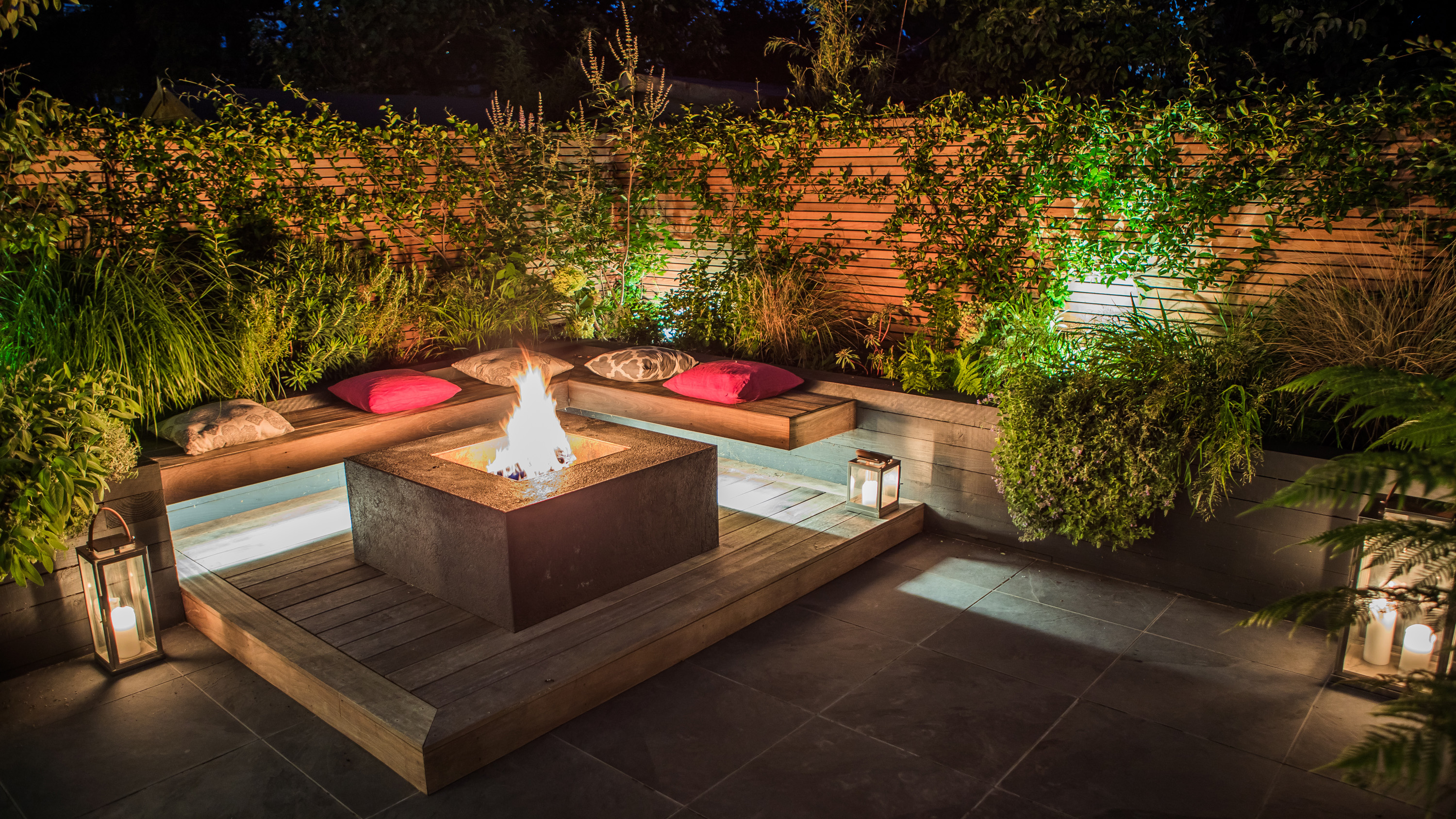

Once you know about outdoor lighting design, you'll feel more confident to plan your garden lighting schemes. Not just for adding atmosphere, the right outdoor lighting can make a huge difference to the look and feel of your outside space. It can spotlight stunning features, help to visually stretch your patch, let you happily cook, read and entertain as well as safely guide the way. It can also change how often you use your gardens too – letting you stay outside well after sundown, not to mention providing a beautiful backdrop for you to view when you’re tucked up indoors.
But how do you get your outdoor lighting design right? Especially as there are so many tantalising new products out there? Directional spotlights, wall washers, the latest outdoor floor lamps and contour LED lighting strips are all seriously tempting, but they do create very different effects, so it’s worth working out exactly what you want to achieve before splashing out.
Of course, your dreams of stunning garden lighting ideas may stretch beyond the odd lighting feature and, instead, dwell on a sophisticated lighting scheme that highlights different parts of the garden – all controlled from your smartphone. If so, is this a job for a specialist lighting designer or something you can plan and install yourself? Need to know more? Then get comfy and keep scrolling.
What are the different types of outdoor lighting design?
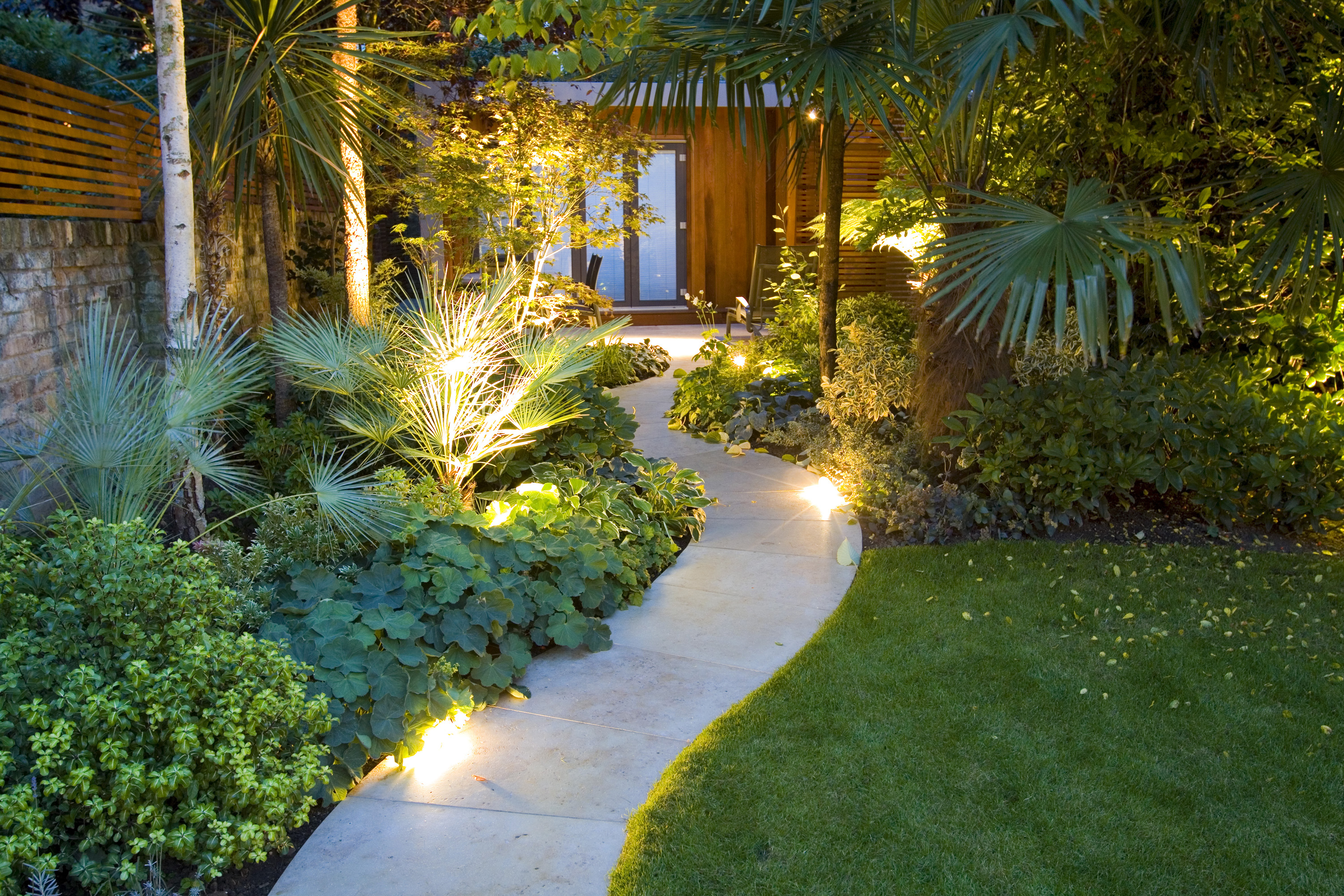
Layering different lighting types creates an inviting space, as in this scheme by Garden Builders
When it comes to choosing the best outdoor lights for your scheme, task, ambient, security and feature lighting all play a part in good outdoor lighting design. The more we use our outside spaces, the more important each becomes.
Good task lighting is key to being able to safely cook, read and cater for guests outside, as well as help guide you safely around the garden, picking out potential hazards such as steps and rills. Bright fixed and adjustable spotlights, downlighters, recessed deck lights and inground indicators are made for this job.
Ambient lighting, such as our stunning festoon light ideas, are all about adding atmosphere, introducing pools of soft, warm light into the blackness to encourage guests to linger, relax and unwind. Wall lights with broad beams of light or dual directions will wash the walls with light, while uplighters softened by foliage will cast a warm, cosy glow, perfect behind seating and for lifting, gloomy corners. Outdoor pendants over dining areas and, hung low over coffee tables also create beautiful features for your space.
‘Feature lighting is essential for making your outdoor space come to life,’ says the team at Lights4Fun. ‘From outdoor candles adorning tabletops to twinkling fairy lights strung over arches and pergolas. By dotting feature lighting around at varying heights, you’ll be able to create a feeling of warmth and cosiness throughout your space. It’s also perfect for showcasing your garden’s best assets. Two or three staked spotlights shining up through a tree or a sculpted shrub will transform it into a stunning feature and add instant X-factor.'
Security lighting will provide peace of mind and help deter intruders. From wall and ceiling mounted fittings, to post, path and floodlights there are plenty of options out to choose from. Of course, these lights don’t have to be permanently on – you won’t be very popular with your neighbours for a start – so sensor activated and Smart tech fittings are well worth considering.
Tailor outdoor lighting design to suit your space

Get started by listing key garden features so you know the main areas you want to illuminate. In this scheme by John Cullen Lighting, the lighting ensures the four trees are the focal point of the space
The trick to planning garden lighting is knowing your plot and understanding how the different spaces fit together. ‘Decide on the areas you want to light, what your key features are and focus on these,’ suggests Sally Storey, Creative Director at John Cullen Lighting.
One simple way to do this is to walk around the space and make a list. Your main priority might be including some great patio lighting ideas, but don’t forget to consider the views from inside your home too, as Sally also mentions, ‘Think of lighting a focal point towards the end of your garden such as a tree or sculpture to extend your view. You can also use spiked lights to add a wash of light to the planting surrounding your alfresco dining area or seating areas.’
Changes in level or surface also need a small amount of light to act as a safety guide while larger, open areas such as a deep border or open stretch of grass can be lit by broader sweeps of light, to create dramatic layers. Decorative highlights such as water features, textured screens and stonework can also be creatively lit to dramatic effect.
One key point to remember though, is that less lighting is more effective. Too many competing lights or strong beams will simply result in a blinding glare, while a few well-chosen and well-placed light sources, will create subtlety, intrigue, and a fascinating result.
Zone your garden with clever outdoor lighting design

By layering different lighting effects you can create different moods, as in this scheme by Garden Builders
Good outdoor lighting design is all about creating atmosphere. Playing with pockets of light and overlaying them to create different effects is all part of the fun, but did you know it can also impact on how you use your outside space? As human beings, we tend to gravitate to a concentration of light, so it makes perfect sense to bathe your outdoor lounge and dining areas in a warm, welcoming glow.
There are plenty of ways to do this, and to suit every budget too. Teaming our pergola ideas with a canopy of fairy lights or adding groups of flickering lanterns are all uber-simple touches that will instantly create a wonderland-like feel.
For a smart, contemporary look that works perfectly with our modern garden ideas, try a more permanent installation. Uplighters in raised borders shining through foliage and wall lights fixed at intervals around a seating area will all cast a soft, gentle light. Add drama and depth with hidden under-seat lighting strips and pinhole deck lights. Illuminated coffee tables and planters also add a fun, party vibe.
The colour and tone of lighting plays a huge part in how an area feels. Warm tones ranging from a soft, white light through to deeper golden shades encourage you to relax and linger while bold, cooler tones of blues, greens and purples create a sense of drama and mystery. Perfect for artistic effect or, perhaps Halloween, but not really suited to a relaxed alfresco supper.
Many smart lighting systems such as Phillips Hue have the option to select and phase between colours, great for endless experimenting. It’s also worth knowing that LED lights come in a wide range of ‘white’ tones. Referred to as colour temperature – these range from icy, blue-white lights, ideal for highlighting crisp architectural details – to a warm white light similar to a fireside glow.
Highlight key features with your garden lighting
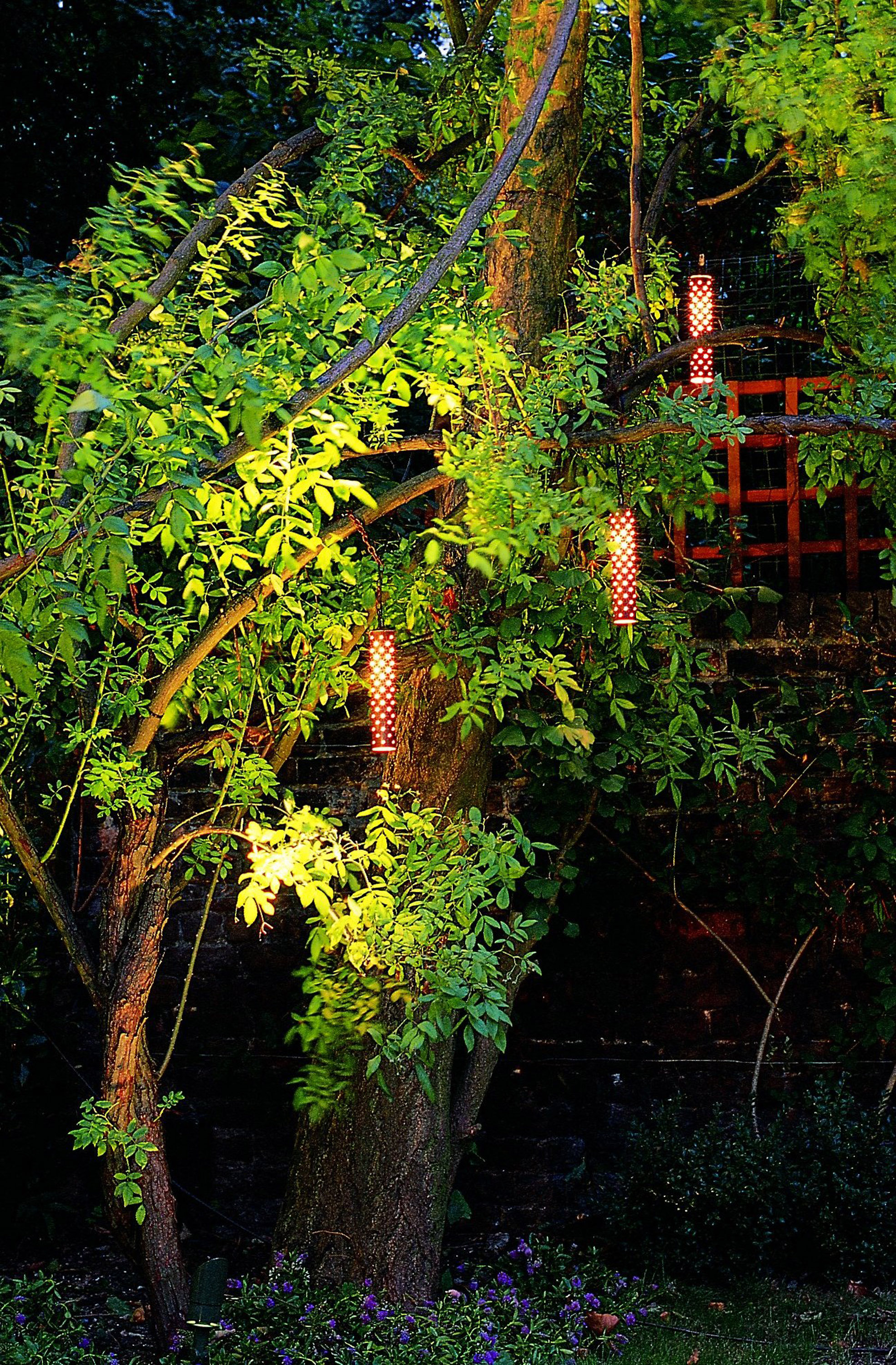
Hang twinkling pendants in trees and shrubs for stunning effects. This Starliter hanging light is from John Cullen Lighting
If you want to show off a favourite sculpture, tree or wall panel, then light it up. It’s the perfect way to enjoy it 24/7 and view it in a slightly different way too. LED Spike garden spotlights can be pushed into the ground and angled to shine up trees and shrubs. Lights vary in reach (or lumens), beam width and can create very different effects. A single spotlight will do the job, but two or three spotlights positioned at different angles will create a more rounded and elegant result.
Wall and surface mounted downlights are also useful, and look best used in pairs, threes or fives. Designs vary in the width, reach and angle of the beam and some fittings combine both up and downward lights for a strikingly, modern look.
For a softer and more informal look, why not position lights within branches or foliage? Look for the latest pendant lights, solar lanterns, or clusters of industrial style filament bulbs, all will cast a gentle glow.
There's plenty more inspiration in our outdoor tree lighting ideas feature.
Include hidden light fittings to add drama
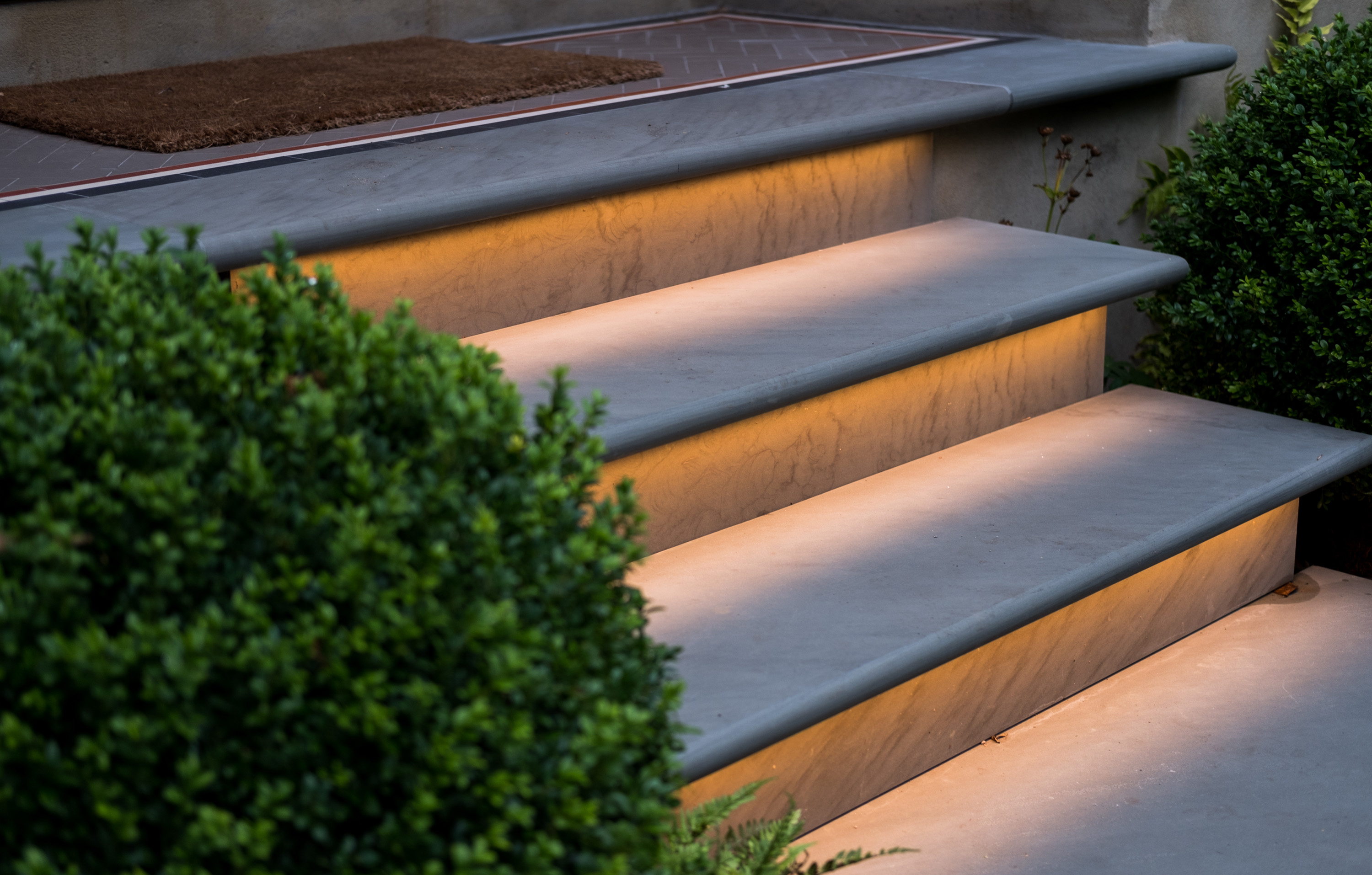
These Grey Yorkstone Bullnose Steps from London Stone have been turned into a a stunning night-time feature with hidden LED strips
Thanks to the arrival of LEDs (light emitting diodes for those that need to know) there are endless possibilities when it comes to choosing fittings for your garden. These tiny units – created by an electrical current passing through a microchip – give out a powerful bright, white light that lasts so much longer than a traditional luminescent light bulb.
In fact, LEDs don’t tend to fail at all, instead they gradually dim over time, but take many years to do so. The beauty of this long-lived light source is that, thanks to its miniscule size, it can be used in many ways.
Low profile strip lighting is a great way to add an extra dimension to your garden steps ideas, as it can sit discreetly under the steps throwing light onto the surface below. This idea works equally well with garden tables and benches too.
Compact indicator and tiny deck lights will sit flush within a paving material, emitting light beams that either hug the surrounding surface or create pinpricks of light. You'll find more inspiration for your modern paving ideas in our feature too.
Go for specialist light fittings for water features
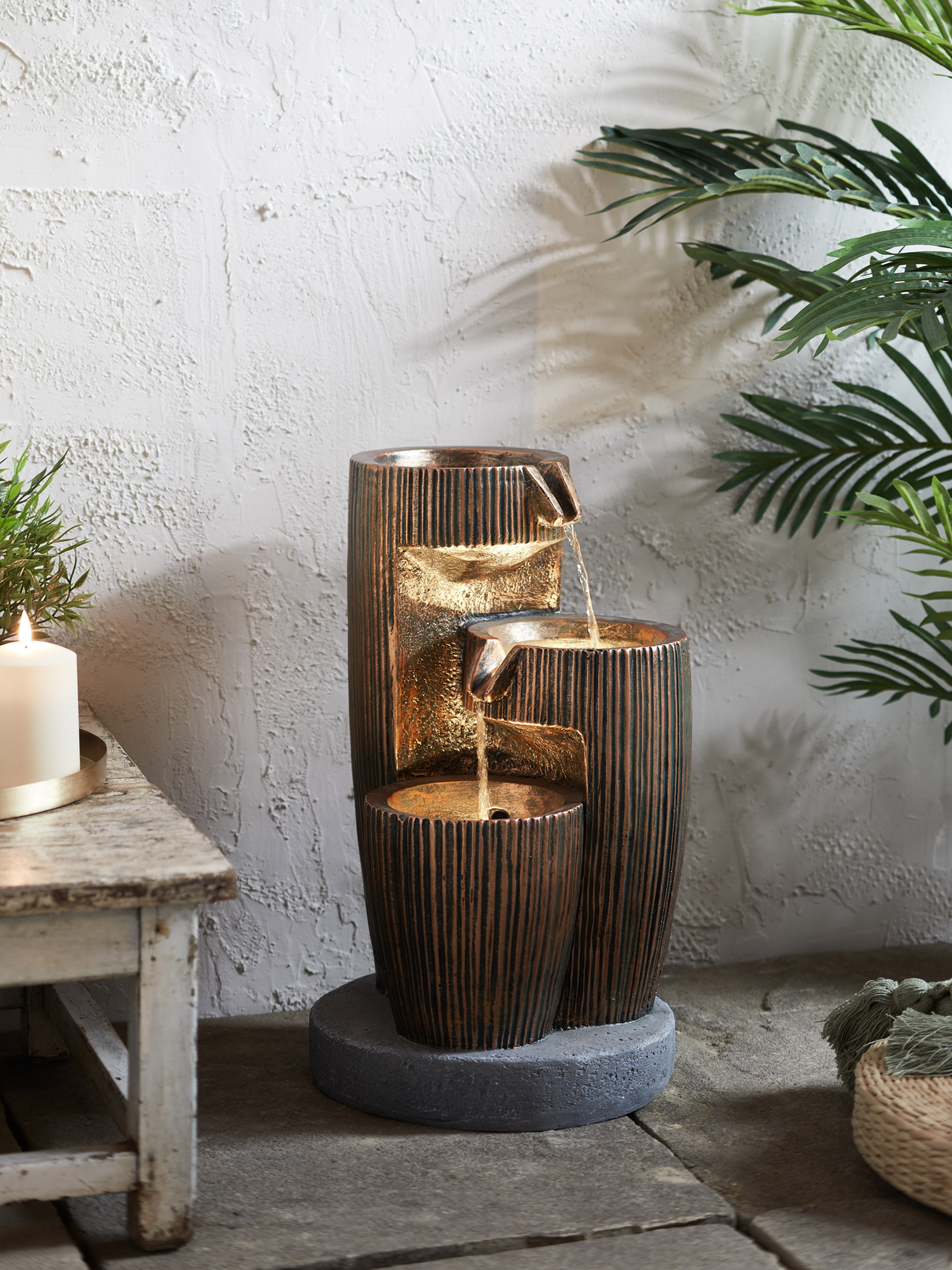
Light up water features for a beautiful effect at night. This bronze garden water feature is from Lights4Fun
The sight of light bouncing off running water is mesmerising and will instantly bring any outdoor space alive. Rills, water chutes, bubbling jets and tranquil ponds are all stunning water feature ideas that will provide endless opportunities to experiment with different types of lighting and create different effects, an opportunity that most professional lighting and garden designer’s relish. Of course, specialised water-safe fittings are a must – a rating of IP68 denotes that a light can be safely used to a depth of 1.5m underwater.
There are a wide range of suitable lights to consider. Spotlights with weighted bases are great for sitting under the water, or for tucking behind the arc of falling water. Their powerful beam will illuminate the feature and create a striking focal point. For a calmer effect try a series of smaller uplighters positioned around the pond or rills edge – perfect for a sharp, contemporary look.
Water blades – those water-channelling, steel spouts that appear from walls, present another exciting lighting opportunity. LED strip lights – often with remote colour changing capabilities – can be fitted within the blade to shine through the water as it cascades into the pool below.
Use indoor-style lights for your outdoor lighting design
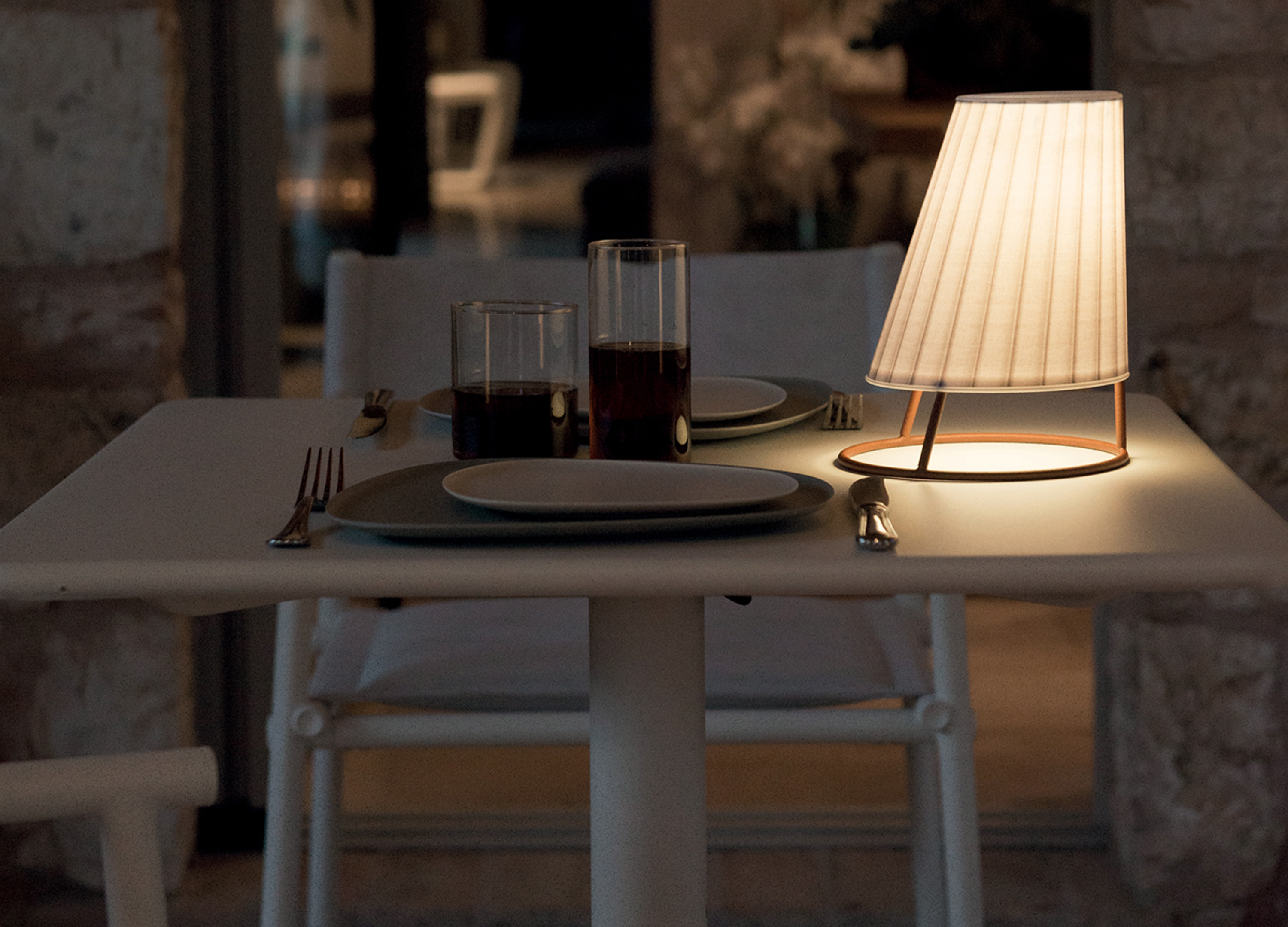
A wireless lamp, such as this Emu Cone garden light from Go Modern, is perfect for relaxing outside
Soft, ambient lighting is every interior designer’s top tool for cosying up a room, so why should outside spaces be any different? With more of us spending time planning our new decking ideas and patios, we need quality lighting that will help us relax, read and entertain as well as create a warm and inviting atmosphere.
Look at the styles of lamp and lighting you use indoors and bring them outdoors to add interest to your outdoor living space ideas and the best garden furniture. Tina Mahony from Go Modern suggests, ‘If you have a favourite garden armchair chair opt for a garden floor lamp, just as you would do with an indoor chair. Outdoor pendant lights are now popular and look incredibly pretty hung from a tree, cast beautiful shadows and a warm ambient light.’
Of course, performance is just as important as looks, so it’s crucial to look for fittings that are safe to use outside. ‘Choose specialist lights that will withstand all weathers,’ adds Tina. ‘Look for frames in materials such as powder-coated aluminium, stainless steel, or solid teak from sustainable sources.’
Improve your home’s security with outdoor lighting
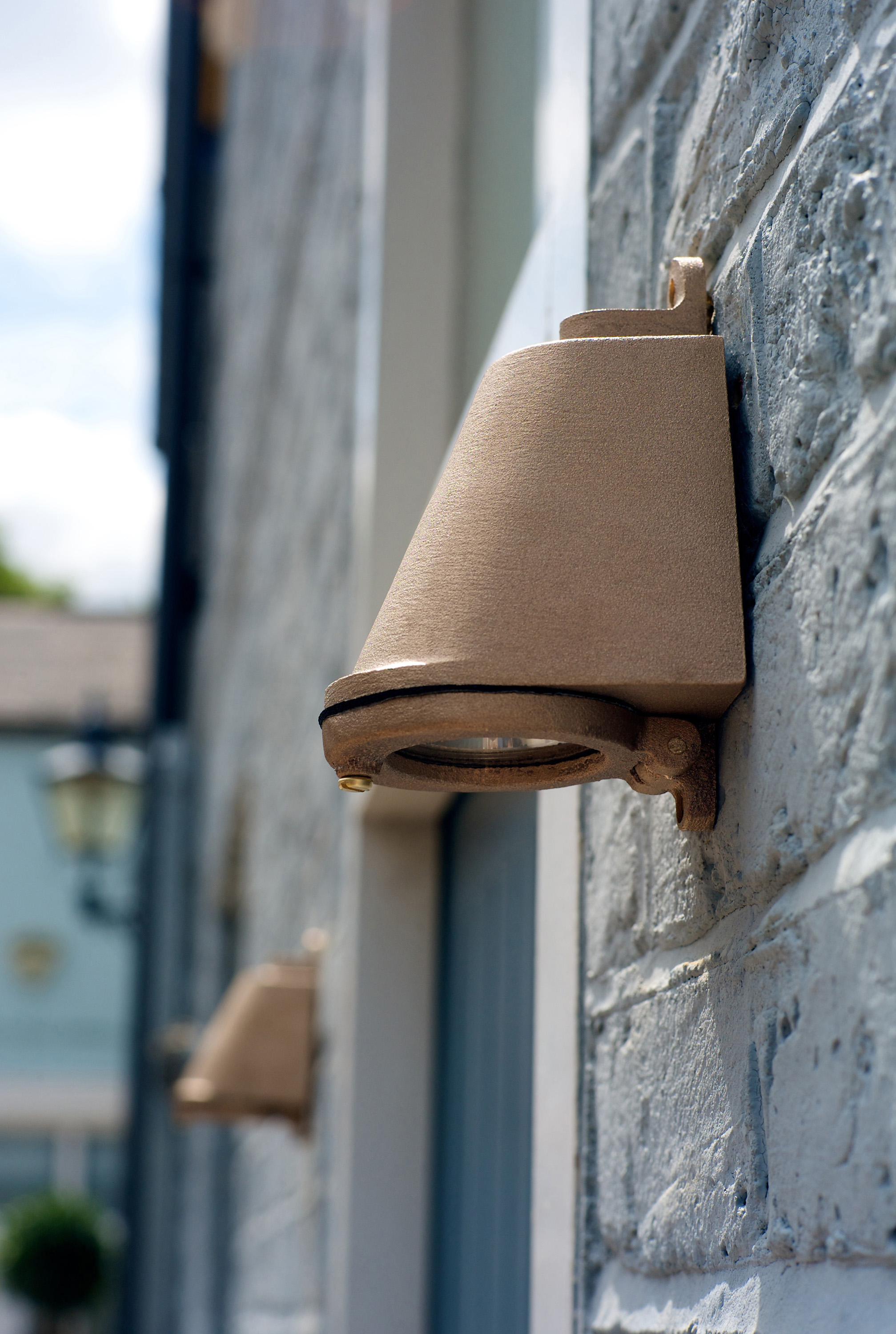
Frame doorways beautifully with a pair of wall mounted downlights. Mast Light in Sandblasted Bronze from Original BTC
Good outdoor lighting can provide reassurance and help deter intruders, providing it’s well-chosen and carefully positioned. There are several different types of security lighting available and the most popular fittings incorporate PIR’s – Passive Infrared sensor which will automatically turn the light on when the sensor detects movement within its range. These lights can be both mains and solar powered.
Manually operated floodlights are another option and are great for lighting the rear or sides of your home. They are powerful though so place and angle them carefully to avoid annoying neighbours and local wildlife. Go for costly but energy saving LEDs or expensive, ultra-bright Halogen floodlights.
Thoughtful siting is key when it comes to how effective these lights are as the team at Primrose explain, ‘The best security lights are motion-activated, have wide beams and give off at least 700 to 1300 lumens. You should place your light near an access point to your home or garden. Fix the light 6 to 10 feet off the ground, facing down and in a position where the light can fill the most space.'
Front doors and porches are obvious places to start. If you have a front porch, try a hanging lantern or discreet downlighter, otherwise a pair of the best outdoor wall lights or surface-hugging mast lights will add a welcoming touch.
Side passageways, garage areas, plus large ground floor expanses of glass – bi-fold and sliding doors etc can all be lit by stylish wall lights, in-set path lights or a series of slender post lights.
Driveways, especially if they are lengthy can also benefit from their own lighting. Regularly spaced bollards, posts or inlaid paving lights will help guide you home and eliminate blackspots, just don’t overdo it or it could have all the appeal of a runway.
Many light fittings can also be synced into a wider, smart home security system, allowing you to monitor your home via your smartphone or other device. Providing added security when you are home or away, you can turn individual lights on or off, or set them to come on as part of a more complex, timed programme. Combine with the best outdoor security cameras and you'll have complete peace of mind.
Take control of your garden lighting
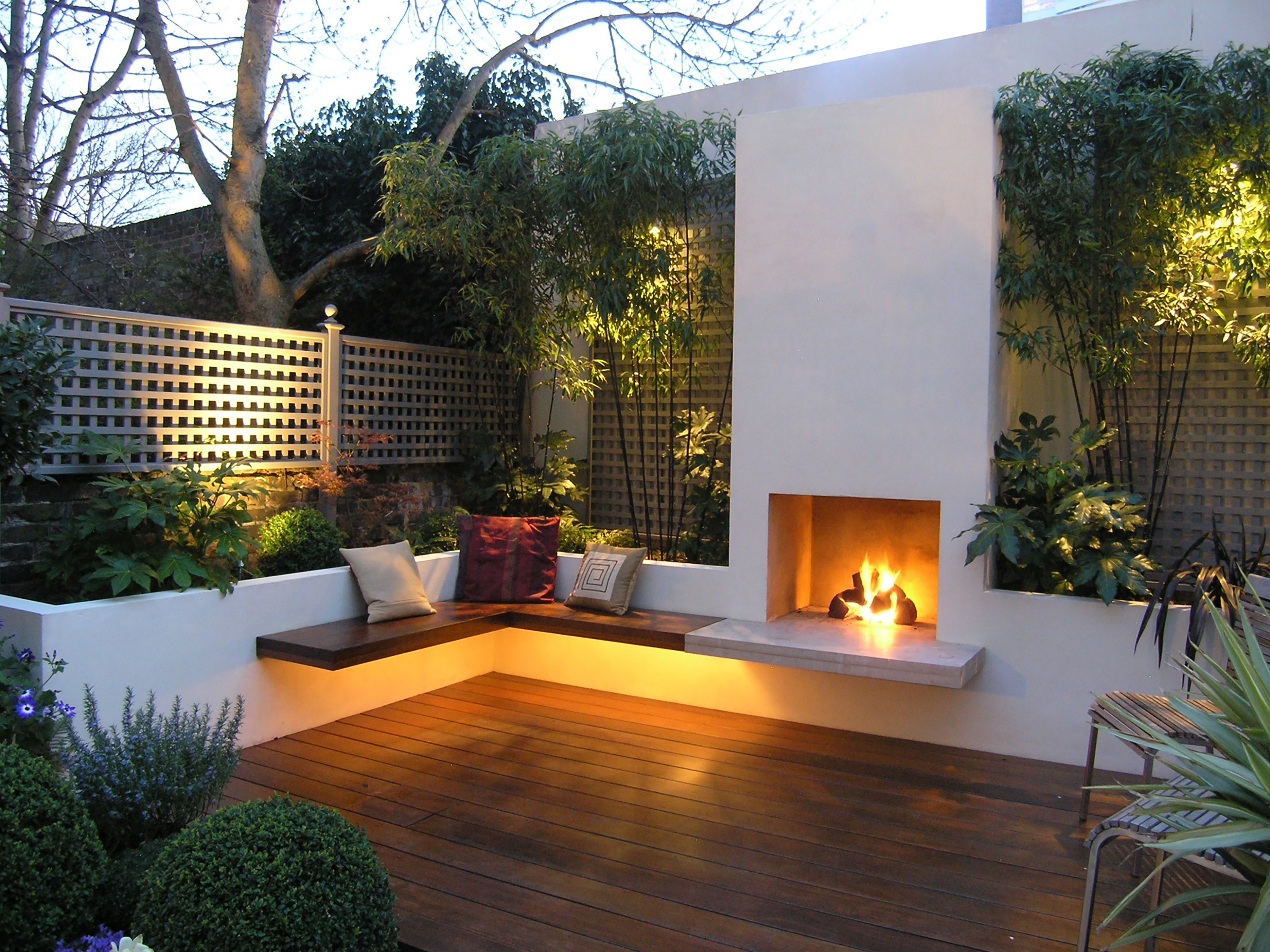
A smart lighting system will let you control and alter the mood via your smartphone or tablet
There’s something intensely satisfying at being able to control and change your garden lighting remotely. Whether to impress your friends or turn the lights on ready for your return home, more and more products have this capability built in.
From individual decorative lights – think colour changing orbs and stools, to strings of connectable fairy and festoons lights and comprehensive, whole-garden lighting designs, each come with either a handy remote or can be controlled via an app or as part of your home’s hub. Lights4fun's Twinkly string lights can be coloured, phased and controlled via the Twinkly Smart App to create magical effects. Clever built-in mapping also enables you to ‘zone’ groups of lights depending on their location, offering endless creativity.
For a more comprehensive remote garden lighting system try Philips Hue. Choose from wall lights, spots, floodlights and pedestals and use them to illuminate your outside space. Linked into a smart home hub you can then control them via an app and enjoy experimenting with endless colours, phasing and zoning options.
As well as changing the look and feel of your lighting, you can also turn smart outdoor light fittings on and off remotely, program them with timer settings or set them to be activated by motion sensor. Dimmer options are also available.
Can you install outdoor lighting designs yourself or do you need to hire a professional?

You may need to hire a professional to install more permanent garden lighting
Whether you can self-install outdoor lighting designs or you need to call in a professional largely depends on the overall effect and type of lighting you are after. Battery powered lights and the best solar lights are, of course, cable free – so can simply be put in place with very little fuss – but things do get a little more complex when it comes more permanent, wired installations.
In the UK, there are essentially there are two different types of cabled garden lighting: Low voltage, a current of 12 volts which produces a gentle, ambient light or High voltage, 230 volts providing enough power for numerous flood and spotlights. Due to its reduced power – a 12-volt lighting system can often be self-installed by a competent homeowner as long as it complies with current regulations. These systems usually include a transformer, pre-formed watertight connectors and cabling that can be laid just below the surface.
Fitting a high-voltage lighting system is a professional job and often one that is tricky to retro-fit too, as armoured cables have to be dug at least 50cm into the ground. Run off your existing supply they would need to be fitted and approved by a certified electrician.
Ready to plan your garden lighting scheme? Then you're probably wondering how much does garden lighting cost? Our guide has all the info you need to plan your budget.

Jill puts her love of plants and all things garden related down to the hours spent pottering around with her Nan and Grandad when she was little. Today she is lucky enough to have a garden of her own in Surrey, England, and spends much of her time writing about them too.
